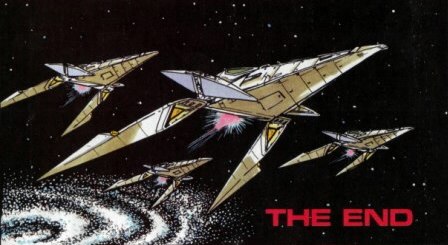 One of the most interesting features of Star Fox is the concept of having wingmen, something most other space shooters did not have back then (I'm trying to think of any that did, but other than the final boss fight of R-Type 2, I'm drawing a blank.) Your wingmen consist of a wise rabbit named Peppy Hare, an energetic frog named Slippy Toad, and a hot-tempered, sarcastic bird named Falco Lombardi. While your wingmen stay behind you out-of-sight most of the time, occasionally they will fly forward to help you out when there are a lot of enemies on the screen. Likewise, sometimes they'll get a enemy locked on their tail, and you'll have to help them out. There are some interesting circumstances where you'll want to allow your wingmen to deal with the enemies, such as in Sector Y, where firing your own laser could result in angering a highly-destructive giant stingray. Though you can annoy your wingmen by accidentally shooting them, thankfully, you can't damage them. Sometimes, they even provide comic relief. The opening cinema shows the Attack Carrier boss descending onto planet Corneria, but you fight a different boss at the end of Corneria Path 3. To explain this, at one point Falco flies on ahead and says, "The Attack Carrier is all mine!" Moments later, you see walker droids carrying off the pieces of the Attack Carrier. One of the most interesting features of Star Fox is the concept of having wingmen, something most other space shooters did not have back then (I'm trying to think of any that did, but other than the final boss fight of R-Type 2, I'm drawing a blank.) Your wingmen consist of a wise rabbit named Peppy Hare, an energetic frog named Slippy Toad, and a hot-tempered, sarcastic bird named Falco Lombardi. While your wingmen stay behind you out-of-sight most of the time, occasionally they will fly forward to help you out when there are a lot of enemies on the screen. Likewise, sometimes they'll get a enemy locked on their tail, and you'll have to help them out. There are some interesting circumstances where you'll want to allow your wingmen to deal with the enemies, such as in Sector Y, where firing your own laser could result in angering a highly-destructive giant stingray. Though you can annoy your wingmen by accidentally shooting them, thankfully, you can't damage them. Sometimes, they even provide comic relief. The opening cinema shows the Attack Carrier boss descending onto planet Corneria, but you fight a different boss at the end of Corneria Path 3. To explain this, at one point Falco flies on ahead and says, "The Attack Carrier is all mine!" Moments later, you see walker droids carrying off the pieces of the Attack Carrier.
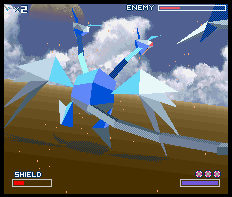 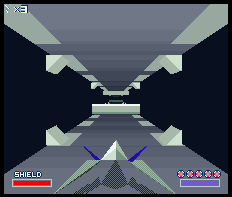 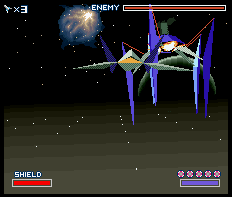
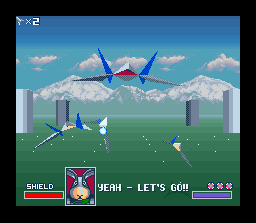 The real innovation of Star Fox is in its brilliant level design. There are two basic types of stages: planet and deep space, and from there they can be further divided into normal planet surfaces (Corneria, Venom, Fortuna), meteor-style rocky surfaces (Meteor, Titania, Macbeth), open deep space stages (Space Armada, Sector Y, Venom Orbital), and deep space obstacle courses (Asteroid, Sector X, Sector Z.) One stage, Venom Base on Path 2, sits in a category by itself as its the only level that takes place entirely inside a corridor (reminiscent of the trench battle in Star Wars). As you encounter these stages, they get harder and harder on the consecutive difficulty paths. For example, the Meteor stage on Path 1 is the first and easiest of the rocky surface levels, with a few canyons and giant robot walkers to watch out for. Macbeth, on Path 3, takes this design much farther, adding a ceiling with additional dangers, like lava-spewing volcanoes. Sector X features spinning space debris in the form of large, free-floating polygonal beams and unfinished structures. Sector Z is a similar concept, but taken to such an insane level that making one mistake could send you bouncing off one beam into another and another and another until you run out of shield power and explode. Planetary battles give you a choice of two views from behind your Arwing, but only deep space stages allow you the first-person view from inside the cockpit of the Arwing. The real innovation of Star Fox is in its brilliant level design. There are two basic types of stages: planet and deep space, and from there they can be further divided into normal planet surfaces (Corneria, Venom, Fortuna), meteor-style rocky surfaces (Meteor, Titania, Macbeth), open deep space stages (Space Armada, Sector Y, Venom Orbital), and deep space obstacle courses (Asteroid, Sector X, Sector Z.) One stage, Venom Base on Path 2, sits in a category by itself as its the only level that takes place entirely inside a corridor (reminiscent of the trench battle in Star Wars). As you encounter these stages, they get harder and harder on the consecutive difficulty paths. For example, the Meteor stage on Path 1 is the first and easiest of the rocky surface levels, with a few canyons and giant robot walkers to watch out for. Macbeth, on Path 3, takes this design much farther, adding a ceiling with additional dangers, like lava-spewing volcanoes. Sector X features spinning space debris in the form of large, free-floating polygonal beams and unfinished structures. Sector Z is a similar concept, but taken to such an insane level that making one mistake could send you bouncing off one beam into another and another and another until you run out of shield power and explode. Planetary battles give you a choice of two views from behind your Arwing, but only deep space stages allow you the first-person view from inside the cockpit of the Arwing.
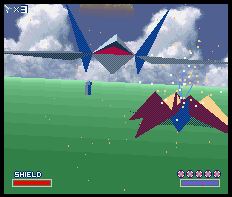 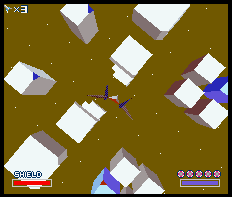 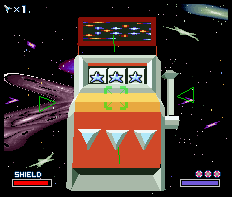
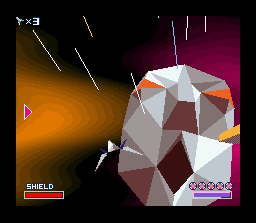 Another huge factor in Star Fox's success as a challenging action game are its colossal boss fights. The bosses are big and have multiple attacks, and many of them change their patterns after they've taken a certain amount of damage. Some of bosses are reused, but many stages have unique bosses and learning to deal with each one will take time, observation, and practice. You'll need to dodge their attacks, which is especially important when trying to survive the bowling ball onslaught from Path 3's Great Commander boss (who bears an uncanny resemblance to the NES R.O.B. peripheral). You'll also have to aim at their weak points (usually flashing) and figure out when best to attack. Shooting at the Blade Barrier boss of Path 3 at the wrong time could result in having your laser fire deflected back at you! Other bosses won't appear to take much (if any) damage until their weak points are destroyed (such as Plasma Hydra), and for others it can be difficult to dodge their attacks while trying to aim at their tiny little weak points (such as the spaceship form of Great Commander). Another huge factor in Star Fox's success as a challenging action game are its colossal boss fights. The bosses are big and have multiple attacks, and many of them change their patterns after they've taken a certain amount of damage. Some of bosses are reused, but many stages have unique bosses and learning to deal with each one will take time, observation, and practice. You'll need to dodge their attacks, which is especially important when trying to survive the bowling ball onslaught from Path 3's Great Commander boss (who bears an uncanny resemblance to the NES R.O.B. peripheral). You'll also have to aim at their weak points (usually flashing) and figure out when best to attack. Shooting at the Blade Barrier boss of Path 3 at the wrong time could result in having your laser fire deflected back at you! Other bosses won't appear to take much (if any) damage until their weak points are destroyed (such as Plasma Hydra), and for others it can be difficult to dodge their attacks while trying to aim at their tiny little weak points (such as the spaceship form of Great Commander).
 Even in cases where a boss is reused, usually something is done to make the encore fight more challenging. It can be frustrating to destroy the barriers that protect the Atomic Core on Path 1's Space Armada. Imagine how much more difficult it is on Path 3's Sector Z where it can reform those barriers. Andross takes more hits on Paths 2 and 3 to kill, and he even has an extra special trick in store on Path 3. (I'll always remember how surprised I was by Andross's form when I first saw it...and how even more surprised I was when I saw what he does on Path 3.) Although Andross is a pretty good final boss, appearing as a giant white virtual reality head (reminiscent of the MCP in the movie TRON) spitting countless monoliths that fill the entire screen, the epitome of the game's challenge is with the Great Commander that comes right before him on Path 3. In some circles, this boss has deservedly earned the nickname "The Boss From Hell". Even in cases where a boss is reused, usually something is done to make the encore fight more challenging. It can be frustrating to destroy the barriers that protect the Atomic Core on Path 1's Space Armada. Imagine how much more difficult it is on Path 3's Sector Z where it can reform those barriers. Andross takes more hits on Paths 2 and 3 to kill, and he even has an extra special trick in store on Path 3. (I'll always remember how surprised I was by Andross's form when I first saw it...and how even more surprised I was when I saw what he does on Path 3.) Although Andross is a pretty good final boss, appearing as a giant white virtual reality head (reminiscent of the MCP in the movie TRON) spitting countless monoliths that fill the entire screen, the epitome of the game's challenge is with the Great Commander that comes right before him on Path 3. In some circles, this boss has deservedly earned the nickname "The Boss From Hell".
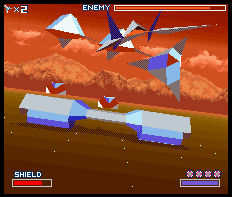 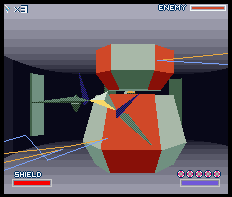 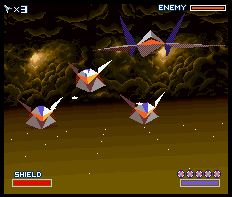
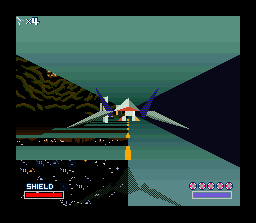 The polygonal graphics are primitive by today's standards, but they still look fantastic in a colorful, surrealistic kind of way. The ship and creature designs are interesting and the animation is amazingly smooth. Despite the complexity of the Arwing and boss designs, they even have real shadows on the planet stages. Enemies include spinning UFO's that drop parachuters, walking droids, ships that look like elaborate kites, mechanical grasshoppers and centipedes. Some stages even feature organic monsters like giant stingrays, squid, mosquitoes, dragons that form arches as they dive in and out of water, and even a two-headed firebreathing bird-dragon boss. The backgrounds are made from standard tiles instead of polygons, and they're usually quite effective. I especially like the Corneria at Sunset background for Path 3, and the lightning and cloud-filled sky of Venom. The view above the city on Venom Base Path 2 is pretty neat, too. There are other cool visual tricks, like fluctuating backgrounds, "vector-line" polygons in Sector Z, lizard pilots that fly out of destroyed ships, and the spectacular explosions. Star Fox has my favorite explosions of any game I've played. The polygonal graphics are primitive by today's standards, but they still look fantastic in a colorful, surrealistic kind of way. The ship and creature designs are interesting and the animation is amazingly smooth. Despite the complexity of the Arwing and boss designs, they even have real shadows on the planet stages. Enemies include spinning UFO's that drop parachuters, walking droids, ships that look like elaborate kites, mechanical grasshoppers and centipedes. Some stages even feature organic monsters like giant stingrays, squid, mosquitoes, dragons that form arches as they dive in and out of water, and even a two-headed firebreathing bird-dragon boss. The backgrounds are made from standard tiles instead of polygons, and they're usually quite effective. I especially like the Corneria at Sunset background for Path 3, and the lightning and cloud-filled sky of Venom. The view above the city on Venom Base Path 2 is pretty neat, too. There are other cool visual tricks, like fluctuating backgrounds, "vector-line" polygons in Sector Z, lizard pilots that fly out of destroyed ships, and the spectacular explosions. Star Fox has my favorite explosions of any game I've played.
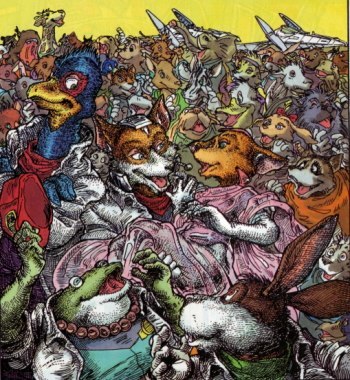 The impact Star Fox had on me as a gamer was to change how I'd look at action-shooter games and what I'd expect from them in general: that a game's music, graphics, characters, control, and challenges could instantly and perfectly meld together to form something that is greater than the sum of its parts. Nintendo could have easily used the Super FX technology to create a novelty graphics demo, but as time goes on and technology advances, it was apparent that eventually there'd be games with graphics that would far outclass what Star Fox had to offer. Therefore, it was necessary for Star Fox to have something else to withstand the test of time, and in that it succeeds: It is fun because it is challenging, with a great learning curve and precise controls. It is engrossing, because even if you're not into the whole "talking cartoon animals" scene, it's easy to forget that and just get caught up in the action, especially when you careen through an armada of star destroyers, taking them on both from the outside and the inside by flying through them and blasting their cores. The impact Star Fox would have on the game industry was more subtle, but important: It began the 3D polygon craze (the packaging of the Sega Genesis game Viewpoint boasts its 3D polygonal graphics), and, according to a Nintendo Power interview, it was the game that inspired Shigeru Miyamoto to create the Nintendo 64, a move that would forever change the face of videogames, for better or for worse. The impact Star Fox had on me as a gamer was to change how I'd look at action-shooter games and what I'd expect from them in general: that a game's music, graphics, characters, control, and challenges could instantly and perfectly meld together to form something that is greater than the sum of its parts. Nintendo could have easily used the Super FX technology to create a novelty graphics demo, but as time goes on and technology advances, it was apparent that eventually there'd be games with graphics that would far outclass what Star Fox had to offer. Therefore, it was necessary for Star Fox to have something else to withstand the test of time, and in that it succeeds: It is fun because it is challenging, with a great learning curve and precise controls. It is engrossing, because even if you're not into the whole "talking cartoon animals" scene, it's easy to forget that and just get caught up in the action, especially when you careen through an armada of star destroyers, taking them on both from the outside and the inside by flying through them and blasting their cores. The impact Star Fox would have on the game industry was more subtle, but important: It began the 3D polygon craze (the packaging of the Sega Genesis game Viewpoint boasts its 3D polygonal graphics), and, according to a Nintendo Power interview, it was the game that inspired Shigeru Miyamoto to create the Nintendo 64, a move that would forever change the face of videogames, for better or for worse.
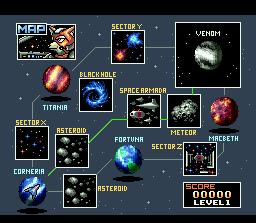 I could not possibly end this article without mentioning Star Fox's phenomenal soundtrack, an epic score by composer Hajime Hirasawa that covers both orchestral and rock tunes with some of the best symphonic music and electric guitar heard on the Super NES. The Corneria theme is your typical (but very good) "rockin' out" type of game tune, but some things are weirder and more daring, like the Titania theme's bizarre opening and distorted notes. The Space Armada and Asteroid tunes perfectly underscore the game's action, while the Main Theme (actually used for the end credits) rivals the work of famous movie soundtrack composer John Williams. One of the more interesting pieces is the waltzy Sector Y music, which complements the ocean-like nature of the level, complete with its cetacean beings. Here I have made available some mp3's of the best songs from the Star Fox soundtrack, including an arranged remake of the Corneria theme that only appeared on certain game CD soundtracks that were available through Nintendo and wasn't actually used in any games. I could not possibly end this article without mentioning Star Fox's phenomenal soundtrack, an epic score by composer Hajime Hirasawa that covers both orchestral and rock tunes with some of the best symphonic music and electric guitar heard on the Super NES. The Corneria theme is your typical (but very good) "rockin' out" type of game tune, but some things are weirder and more daring, like the Titania theme's bizarre opening and distorted notes. The Space Armada and Asteroid tunes perfectly underscore the game's action, while the Main Theme (actually used for the end credits) rivals the work of famous movie soundtrack composer John Williams. One of the more interesting pieces is the waltzy Sector Y music, which complements the ocean-like nature of the level, complete with its cetacean beings. Here I have made available some mp3's of the best songs from the Star Fox soundtrack, including an arranged remake of the Corneria theme that only appeared on certain game CD soundtracks that were available through Nintendo and wasn't actually used in any games.
|
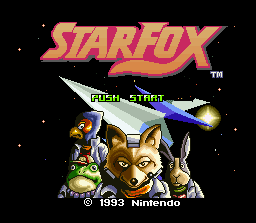
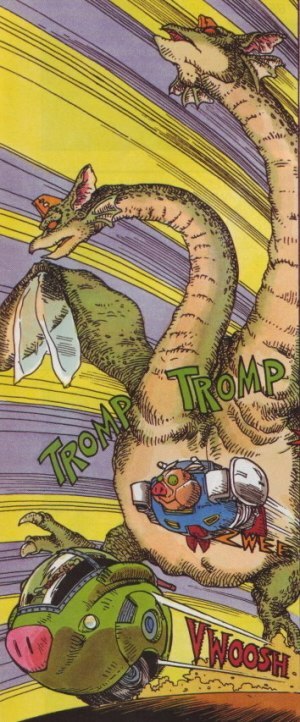
 One of the most interesting features of Star Fox is the concept of having wingmen, something most other space shooters did not have back then (I'm trying to think of any that did, but other than the final boss fight of R-Type 2, I'm drawing a blank.) Your wingmen consist of a wise rabbit named Peppy Hare, an energetic frog named Slippy Toad, and a hot-tempered, sarcastic bird named Falco Lombardi. While your wingmen stay behind you out-of-sight most of the time, occasionally they will fly forward to help you out when there are a lot of enemies on the screen. Likewise, sometimes they'll get a enemy locked on their tail, and you'll have to help them out. There are some interesting circumstances where you'll want to allow your wingmen to deal with the enemies, such as in Sector Y, where firing your own laser could result in angering a highly-destructive giant stingray. Though you can annoy your wingmen by accidentally shooting them, thankfully, you can't damage them. Sometimes, they even provide comic relief. The opening cinema shows the Attack Carrier boss descending onto planet Corneria, but you fight a different boss at the end of Corneria Path 3. To explain this, at one point Falco flies on ahead and says, "The Attack Carrier is all mine!" Moments later, you see walker droids carrying off the pieces of the Attack Carrier.
One of the most interesting features of Star Fox is the concept of having wingmen, something most other space shooters did not have back then (I'm trying to think of any that did, but other than the final boss fight of R-Type 2, I'm drawing a blank.) Your wingmen consist of a wise rabbit named Peppy Hare, an energetic frog named Slippy Toad, and a hot-tempered, sarcastic bird named Falco Lombardi. While your wingmen stay behind you out-of-sight most of the time, occasionally they will fly forward to help you out when there are a lot of enemies on the screen. Likewise, sometimes they'll get a enemy locked on their tail, and you'll have to help them out. There are some interesting circumstances where you'll want to allow your wingmen to deal with the enemies, such as in Sector Y, where firing your own laser could result in angering a highly-destructive giant stingray. Though you can annoy your wingmen by accidentally shooting them, thankfully, you can't damage them. Sometimes, they even provide comic relief. The opening cinema shows the Attack Carrier boss descending onto planet Corneria, but you fight a different boss at the end of Corneria Path 3. To explain this, at one point Falco flies on ahead and says, "The Attack Carrier is all mine!" Moments later, you see walker droids carrying off the pieces of the Attack Carrier.









 The real innovation of Star Fox is in its brilliant level design. There are two basic types of stages: planet and deep space, and from there they can be further divided into normal planet surfaces (Corneria, Venom, Fortuna), meteor-style rocky surfaces (Meteor, Titania, Macbeth), open deep space stages (Space Armada, Sector Y, Venom Orbital), and deep space obstacle courses (Asteroid, Sector X, Sector Z.) One stage, Venom Base on Path 2, sits in a category by itself as its the only level that takes place entirely inside a corridor (reminiscent of the trench battle in Star Wars). As you encounter these stages, they get harder and harder on the consecutive difficulty paths. For example, the Meteor stage on Path 1 is the first and easiest of the rocky surface levels, with a few canyons and giant robot walkers to watch out for. Macbeth, on Path 3, takes this design much farther, adding a ceiling with additional dangers, like lava-spewing volcanoes. Sector X features spinning space debris in the form of large, free-floating polygonal beams and unfinished structures. Sector Z is a similar concept, but taken to such an insane level that making one mistake could send you bouncing off one beam into another and another and another until you run out of shield power and explode. Planetary battles give you a choice of two views from behind your Arwing, but only deep space stages allow you the first-person view from inside the cockpit of the Arwing.
The real innovation of Star Fox is in its brilliant level design. There are two basic types of stages: planet and deep space, and from there they can be further divided into normal planet surfaces (Corneria, Venom, Fortuna), meteor-style rocky surfaces (Meteor, Titania, Macbeth), open deep space stages (Space Armada, Sector Y, Venom Orbital), and deep space obstacle courses (Asteroid, Sector X, Sector Z.) One stage, Venom Base on Path 2, sits in a category by itself as its the only level that takes place entirely inside a corridor (reminiscent of the trench battle in Star Wars). As you encounter these stages, they get harder and harder on the consecutive difficulty paths. For example, the Meteor stage on Path 1 is the first and easiest of the rocky surface levels, with a few canyons and giant robot walkers to watch out for. Macbeth, on Path 3, takes this design much farther, adding a ceiling with additional dangers, like lava-spewing volcanoes. Sector X features spinning space debris in the form of large, free-floating polygonal beams and unfinished structures. Sector Z is a similar concept, but taken to such an insane level that making one mistake could send you bouncing off one beam into another and another and another until you run out of shield power and explode. Planetary battles give you a choice of two views from behind your Arwing, but only deep space stages allow you the first-person view from inside the cockpit of the Arwing.
 Another huge factor in Star Fox's success as a challenging action game are its colossal boss fights. The bosses are big and have multiple attacks, and many of them change their patterns after they've taken a certain amount of damage. Some of bosses are reused, but many stages have unique bosses and learning to deal with each one will take time, observation, and practice. You'll need to dodge their attacks, which is especially important when trying to survive the bowling ball onslaught from Path 3's Great Commander boss (who bears an uncanny resemblance to the
Another huge factor in Star Fox's success as a challenging action game are its colossal boss fights. The bosses are big and have multiple attacks, and many of them change their patterns after they've taken a certain amount of damage. Some of bosses are reused, but many stages have unique bosses and learning to deal with each one will take time, observation, and practice. You'll need to dodge their attacks, which is especially important when trying to survive the bowling ball onslaught from Path 3's Great Commander boss (who bears an uncanny resemblance to the  Even in cases where a boss is reused, usually something is done to make the encore fight more challenging. It can be frustrating to destroy the barriers that protect the Atomic Core on Path 1's Space Armada. Imagine how much more difficult it is on Path 3's Sector Z where it can reform those barriers. Andross takes more hits on Paths 2 and 3 to kill, and he even has an extra special trick in store on Path 3. (I'll always remember how surprised I was by Andross's form when I first saw it...and how even more surprised I was when I saw what he does on Path 3.) Although Andross is a pretty good final boss, appearing as a giant white virtual reality head (reminiscent of the MCP in the movie TRON) spitting countless monoliths that fill the entire screen, the epitome of the game's challenge is with the Great Commander that comes right before him on Path 3. In some circles, this boss has deservedly earned the nickname "The Boss From Hell".
Even in cases where a boss is reused, usually something is done to make the encore fight more challenging. It can be frustrating to destroy the barriers that protect the Atomic Core on Path 1's Space Armada. Imagine how much more difficult it is on Path 3's Sector Z where it can reform those barriers. Andross takes more hits on Paths 2 and 3 to kill, and he even has an extra special trick in store on Path 3. (I'll always remember how surprised I was by Andross's form when I first saw it...and how even more surprised I was when I saw what he does on Path 3.) Although Andross is a pretty good final boss, appearing as a giant white virtual reality head (reminiscent of the MCP in the movie TRON) spitting countless monoliths that fill the entire screen, the epitome of the game's challenge is with the Great Commander that comes right before him on Path 3. In some circles, this boss has deservedly earned the nickname "The Boss From Hell".
 The polygonal graphics are primitive by today's standards, but they still look fantastic in a colorful, surrealistic kind of way. The ship and creature designs are interesting and the animation is amazingly smooth. Despite the complexity of the Arwing and boss designs, they even have real shadows on the planet stages. Enemies include spinning UFO's that drop parachuters, walking droids, ships that look like elaborate kites, mechanical grasshoppers and centipedes. Some stages even feature organic monsters like giant stingrays, squid, mosquitoes, dragons that form arches as they dive in and out of water, and even a two-headed firebreathing bird-dragon boss. The backgrounds are made from standard tiles instead of polygons, and they're usually quite effective. I especially like the Corneria at Sunset background for Path 3, and the lightning and cloud-filled sky of Venom. The view above the city on Venom Base Path 2 is pretty neat, too. There are other cool visual tricks, like fluctuating backgrounds, "vector-line" polygons in Sector Z, lizard pilots that fly out of destroyed ships, and the spectacular explosions. Star Fox has my favorite explosions of any game I've played.
The polygonal graphics are primitive by today's standards, but they still look fantastic in a colorful, surrealistic kind of way. The ship and creature designs are interesting and the animation is amazingly smooth. Despite the complexity of the Arwing and boss designs, they even have real shadows on the planet stages. Enemies include spinning UFO's that drop parachuters, walking droids, ships that look like elaborate kites, mechanical grasshoppers and centipedes. Some stages even feature organic monsters like giant stingrays, squid, mosquitoes, dragons that form arches as they dive in and out of water, and even a two-headed firebreathing bird-dragon boss. The backgrounds are made from standard tiles instead of polygons, and they're usually quite effective. I especially like the Corneria at Sunset background for Path 3, and the lightning and cloud-filled sky of Venom. The view above the city on Venom Base Path 2 is pretty neat, too. There are other cool visual tricks, like fluctuating backgrounds, "vector-line" polygons in Sector Z, lizard pilots that fly out of destroyed ships, and the spectacular explosions. Star Fox has my favorite explosions of any game I've played.
 The impact Star Fox had on me as a gamer was to change how I'd look at action-shooter games and what I'd expect from them in general: that a game's music, graphics, characters, control, and challenges could instantly and perfectly meld together to form something that is greater than the sum of its parts. Nintendo could have easily used the Super FX technology to create a novelty graphics demo, but as time goes on and technology advances, it was apparent that eventually there'd be games with graphics that would far outclass what Star Fox had to offer. Therefore, it was necessary for Star Fox to have something else to withstand the test of time, and in that it succeeds: It is fun because it is challenging, with a great learning curve and precise controls. It is engrossing, because even if you're not into the whole "talking cartoon animals" scene, it's easy to forget that and just get caught up in the action, especially when you careen through an armada of star destroyers, taking them on both from the outside and the inside by flying through them and blasting their cores. The impact Star Fox would have on the game industry was more subtle, but important: It began the 3D polygon craze (the packaging of the Sega Genesis game Viewpoint boasts its 3D polygonal graphics), and, according to a Nintendo Power interview, it was the game that inspired Shigeru Miyamoto to create the Nintendo 64, a move that would forever change the face of videogames, for better or for worse.
The impact Star Fox had on me as a gamer was to change how I'd look at action-shooter games and what I'd expect from them in general: that a game's music, graphics, characters, control, and challenges could instantly and perfectly meld together to form something that is greater than the sum of its parts. Nintendo could have easily used the Super FX technology to create a novelty graphics demo, but as time goes on and technology advances, it was apparent that eventually there'd be games with graphics that would far outclass what Star Fox had to offer. Therefore, it was necessary for Star Fox to have something else to withstand the test of time, and in that it succeeds: It is fun because it is challenging, with a great learning curve and precise controls. It is engrossing, because even if you're not into the whole "talking cartoon animals" scene, it's easy to forget that and just get caught up in the action, especially when you careen through an armada of star destroyers, taking them on both from the outside and the inside by flying through them and blasting their cores. The impact Star Fox would have on the game industry was more subtle, but important: It began the 3D polygon craze (the packaging of the Sega Genesis game Viewpoint boasts its 3D polygonal graphics), and, according to a Nintendo Power interview, it was the game that inspired Shigeru Miyamoto to create the Nintendo 64, a move that would forever change the face of videogames, for better or for worse.
 I could not possibly end this article without mentioning Star Fox's phenomenal soundtrack, an epic score by composer Hajime Hirasawa that covers both orchestral and rock tunes with some of the best symphonic music and electric guitar heard on the Super NES. The Corneria theme is your typical (but very good) "rockin' out" type of game tune, but some things are weirder and more daring, like the Titania theme's bizarre opening and distorted notes. The Space Armada and Asteroid tunes perfectly underscore the game's action, while the Main Theme (actually used for the end credits) rivals the work of famous movie soundtrack composer John Williams. One of the more interesting pieces is the waltzy Sector Y music, which complements the ocean-like nature of the level, complete with its cetacean beings. Here I have made available some mp3's of the best songs from the Star Fox soundtrack, including an arranged remake of the Corneria theme that only appeared on certain game CD soundtracks that were available through Nintendo and wasn't actually used in any games.
I could not possibly end this article without mentioning Star Fox's phenomenal soundtrack, an epic score by composer Hajime Hirasawa that covers both orchestral and rock tunes with some of the best symphonic music and electric guitar heard on the Super NES. The Corneria theme is your typical (but very good) "rockin' out" type of game tune, but some things are weirder and more daring, like the Titania theme's bizarre opening and distorted notes. The Space Armada and Asteroid tunes perfectly underscore the game's action, while the Main Theme (actually used for the end credits) rivals the work of famous movie soundtrack composer John Williams. One of the more interesting pieces is the waltzy Sector Y music, which complements the ocean-like nature of the level, complete with its cetacean beings. Here I have made available some mp3's of the best songs from the Star Fox soundtrack, including an arranged remake of the Corneria theme that only appeared on certain game CD soundtracks that were available through Nintendo and wasn't actually used in any games.
